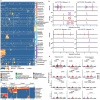This is a preprint.
Empirically establishing drug exposure records directly from untargeted metabolomics data
- PMID: 39416075
- PMCID: PMC11482764
- DOI: 10.1101/2024.10.07.617109
Empirically establishing drug exposure records directly from untargeted metabolomics data
Abstract
Despite extensive efforts, extracting information on medication exposure from clinical records remains challenging. To complement this approach, we developed the tandem mass spectrometry (MS/MS) based GNPS Drug Library. This resource integrates MS/MS data for drugs and their metabolites/analogs with controlled vocabularies on exposure sources, pharmacologic classes, therapeutic indications, and mechanisms of action. It enables direct analysis of drug exposure and metabolism from untargeted metabolomics data independent of clinical records. Our library facilitates stratification of individuals in clinical studies based on the empirically detected medications, exemplified by drug-dependent microbiota-derived N-acyl lipid changes in a cohort with human immunodeficiency virus. The GNPS Drug Library holds potential for broader applications in drug discovery and precision medicine.
Figures


References
-
- National Center for Health Statistics (U.S.), Health, United States, 2019 (U.S. Centers for Disease Control and Prevention, 2021).
-
- de la Cuesta-Zuluaga J., Boldt L. & Maier L. Response, resistance, and recovery of gut bacteria to human-targeted drug exposure. Cell Host Microbe 32, 786–793 (2024). - PubMed
Publication types
Grants and funding
LinkOut - more resources
Full Text Sources
